|
Nancy Brashear and Carolyn Angus In 2020, we welcomed the release of new editions of some old favorites. Join us in celebrating the anniversaries of these picture books and novels that were loved by readers when they were first published and will make meaningful and exciting reading for those discovering them for the first time. 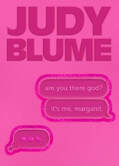 Are You There God? It’s Me, Margaret (50th Anniversary Edition). Judy Blume. (2020). Richard Jackson/Atheneum. Almost twelve-year-old Margaret’s life changes when her family moves from New York City to Farbrook, New Jersey. The new girl in class, she becomes a member of a secret club, the Four PTS’s (Pre-Teen Sensations) and tries to fit in despite their cliquish ways and preoccupation with personal bodily changes and boys. She’s also the only girl whose family doesn’t belong to a synagogue or church. Since her parents have told her she can choose a religion for herself when she’s grown up, this becomes an important part of her regular private conversations with God about intimate aspects of her life. For her year-long school project, Margaret conducts an experiment in religion. She reads books on Judaism and Christianity and visits Temple Israel and various Protestant and Catholic churches. Her conclusion: Twelve is very late to learn about religion. The 50th anniversary edition of this middle-grade novel in which Judy Blume deals with the important certainties and uncertainties of adolescence with understanding and wit features a rose-colored faux leather embossed cover. (Gr 6-8) 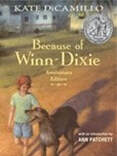 Because of Winn-Dixie (20th Anniversary Edition). Kate DiCamillo. (2020). Candlewick. India Opal Buloni lives in Naomi, Florida, where her father is the new preacher at the Open Arms Baptist Church. Opal is preoccupied with wanting to understand why her mother left when she was an infant and why her father never wants to talk about her. Opal convinces her father to let her keep the unkempt, stray dog she names Winn-Dixie (named after the grocery store where she found him). Winn-Dixie becomes Opal’s entry into interconnected friendships with elderly Gloria Dump at the “haunted house,” Miss Franny at the library, Otis at the pet store, and others in the neighborhood. Opal learns that most people have suffered loss and that “you can only love what you got while you got it.” This anniversary edition of Kate DiCamillo’s 2001 Newbery Honor book features an introduction by author Ann Patchett and an afterword by DiCamillo. (Gr 3-5) 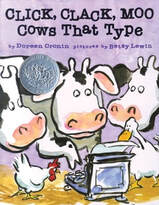 Click, Clack, Moo: Cows That Type (20th Anniversary Edition). Doreen Cronin. Illus. by Betsy Lewin. (2020). Caitlyn Dlouhy/Atheneum. “Click, clack, moo. Click, clack, moo. Clickety, clack, moo.” The cows use the old typewriter they find to write a note to Farmer Brown requesting electric blankets because it’s cold in the barn. When no blankets appear, they post another note on the barn door. “Sorry. We’re closed. No milk today.” After the hens join the strike, Farmer Brown sends Duck, a “neutral party,” with his demand for milk and eggs. The cows respond with a compromise that the farmer accepts: an exchange of the typewriter for blankets. Betsy Lewin’s humorous 2001 Caldecott Honor-winning illustrations show the cows and hens sleeping contently under their electric blankets, but instead of the typewriter, Farmer Brown gets a message from the ducks. “Click, clack, quack. Click, clack, quack. Clickety, clack, quack.” The promise of more trouble and fun in the barnyard suggested by this ending has been fulfilled in Cronin and Lewin’s numerous additions to the Click, Clack, Moo series. (PreK-Gr2)  Frog and Toad Are Friends (50th Anniversary Commemorative Edition). Arnold Lobel. (2020). Harper/HarperCollins. To celebrate the 50th anniversary of Arnold Lobel’s 1971 Caldecott-Honor-winning Frog and Toad Are Friends, HarperCollins reissued this first Frog and Toad book (originally published in the I Can Read series) in a larger picture book format. Five short stories—“Spring,” “The Story,” “A Lost Button,” “A Swim,” and “The Letter”—tell about the small dilemmas of two best friends who always seem to enjoy themselves as they help each other out. Bonus material in this commemorative edition includes archival photographs, a biography of Arnold Lobel (1933-1987), notes and sketches on the origin of Frog and Toad, information on Lobel’s process of writing and creating the artwork for the book, and quotes. Plan on continuing the joy of reading this beloved classic by sharing Frog and Toad Together (1972), Frog and Toad All Year (1976), and Days with Frog and Toad (1979). (PreK-Gr2) 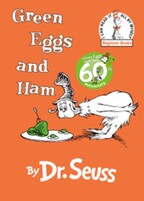 Green Eggs and Ham. Dr. Seuss. (1960). Beginner Books/Random House. “Do you like / green eggs and ham?” // “I do not like them, / Sam-I-am. / I do not like / green eggs and ham.” Dr. Seuss is at his best in the use of rhyme and repetition as Sam-I-am offers up green eggs and ham in different nonsensical ways in various locations and with three animals (mouse, fox, and goat) in an effort to entice a decidedly contrary older Seussian character to just try them. Finally, agreeing to do so if Sam-I-am will stop pestering him, he licks the platter clean. “I do like / green eggs and ham! / Thank you! Thank you, / Sam-I-am!” This fun to read I Can Read It All by Myself Beginner Book, created by Theodor Geisel (1904-1991) using only fifty words, celebrated its 60th anniversary in 2020. (PreK-Gr2) 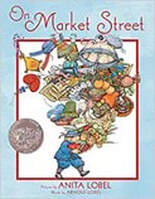 On Market Street. Arnold Lobel. Illus. by Anita Lobel. (2020). Paula Wiseman/Simon & Schuster. On a stroll along Market Street, a young boy buys twenty-six presents for a friend from merchants exquisitely dressed in items for sale in their shops. At the end of the day, having spent all his coins on Market Street, the boy returns home with an alphabet of gifts—apples, books, clocks, doughnuts, . . . yarn, zippers—to present to his cat before he and the cat nestle in bed for the night. As Anita Lobel explains in an illustrator’s note, Arnold Lobel wrote the “bookend” verses that frame her alphabet of imaginatively dressed shopkeepers inspired by a display of seventeenth-century posters of figures constructed of objects of trades she saw in Paris. This 1982 Caldecott Honor book, originally published by Greenwillow Books, is celebrating its 40th anniversary in 2021. (PreK-Gr 2)  The Shrinking of Treehorn (50th Anniversary Edition). Florence Parry Heide. Illus. by Edward Gorey. (2020). Holiday House. Treehorn is shrinking, day by day, and his parents don’t seem to be concerned. At breakfast, he sits on a pile of cushions so he can finish off his cereal and send away for the game advertised on the back of the box. He needs help getting his piggy bank down from the counter to pay for the game and can’t reach the mailbox without help. Even Treehorn’s teacher and principal don’t pay attention to what’s happening to him. One morning, smaller than ever, Treehorn spies his unfinished cereal box game, The Big Game for Kids to Grow On, under his bed and ingeniously takes control of the situation himself. That is, until later, when he notices he’s green all over and sighs, “If I don’t say anything, they won’t notice.” Edward Gorey’s distinctive pen-and-ink drawings perfectly match Florence Parry Heide’s quirky, melancholic story of how it feels to be ignored. New features include a foreword by author Lane Smith, a February 2010 interview with the author from curiouspages.blospot.com, and an article by her son published in the Kenosha News in 2009. (PreK-Gr 2) 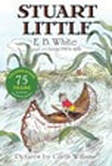 Stuart Little (75th Anniversary Edition). E. B. White. Illus. by Garth Williams. (2020). Harper/HarperCollins. Stuart Little, a mouse born to a human family, sets out on the biggest adventure of his life when he runs away from home to look for his best friend Margalo, a little bird who has mysteriously disappeared. Stuart, who has outwitted the Little’s cat, navigated the streets of New York City, and steered a toy schooner on a perilous course to win a sailboat race in Central Park, confidently heads north, knowing the way will be long. “But the sky was bright, and he somehow felt he was headed in the right direction.” White’s final sentence leaves the reader not knowing whether Stuart and Margalo are reunited but feeling that, for adventure-loving Stuart, the search was the important thing. This special edition includes a foreword by author Sara Pennypacker and two bonus items from HarperCollin’s archives: the cover letter White sent to his editor along with an unfinished manuscript for Stuart Little and a 1945 catalog advertisement for the book. (Gr 3-5)  The Trumpet of the Swan (50th Anniversary Edition). E. B. White. Illus. by Fred Marcello. (2200. Harper/HarperCollins. Louis is a trumpeter swan who was born voiceless. Although he has learned to read and write by going to school with Sam Beaver, a boy he first met in the wilderness of western Canada, and can communicate with humans by writing on a slate, Louis is still unable to connect orally with other swans. His father’s stealing of a brass trumpet from a music store so that Louis can honk “Ko-hoh, ko-hoh!” leads to much more than just the ability to woo Serena, the swan he loves. This special edition includes a foreword by John Lithgow and bonus material: a 1970 advertisement for the book in the New York Times; a letter from E. B. White to his editor, Ursula Nordstrom; a letter White sent to readers; and excerpts from Charlotte’s Web and Stuart Little. For a special treat, enjoy the Listening Library (2006) audio production of The Trumpet of the Swan read by E. B. White, which includes trumpet playing that brings Louis’ music to life. (Gr 3-5)  The Watson Go to Birmingham—1963 (25th Anniversary Edition). Christopher Paul Curtis. (2020). Yearling/Random House. Ten-year-old African American Kenny Watson and the other “Weird Watsons.” (Momma, Dad, younger sister Joetta, and thirteen-year-old Byron) live in Flint, Michigan. After Byron, an “official juvenile delinquent,” continues to get into trouble, Momma decides it’s time for Grandma Sands to straighten him out during the summer, so the Watsons pile into the Brown Bomber, the family car, and head to Birmingham, Alabama. Kenny is shocked by segregation in the South and the blatant and dangerous attitudes of some whites toward blacks. On a Sunday, when Joetta is in Sunday School, the church is bombed. Kenny witnesses the aftermath and believes his sister has been killed. Although it turns out Joetta is safe, four young girls died that day. The Watson family returns to Flint with Kenny forever changed by his personal introduction to the tragedies of racial injustice. This paperback edition of Christopher Paul Curtis’ Newbery Honor-winning book includes a new foreword and afterword by the author; tributes by Jacqueline Woodson, Kate DiCamillo, and Varian Johnson; original manuscript pages; a letter from the 1996 Newbery committee; and a map of the Watson’s journey. (Gr 3 Up) Nancy Brashear is Professor Emeritus of English from Azusa Pacific University, in Azusa California. Carolyn Angus is former Director of the George G. Stone Center for Children’s Books, Claremont Graduate University, in Claremont, California.
1 Comment
Nancy Brashear and Carolyn Angus As reviewers, one of the tasks we undertake each January is the weeding of our crowded bookshelves to make room for new releases. As life-long book lovers, we add some books to our personal collections, and put some aside for the grandchild or special friend whom we know will love them too. As advocates of reading, we’ll send the others to schools and libraries, but before we do, here is our list of books published in 2020 that are too good to miss—books we would love to see in the hands of all children and teachers.  Butterflies Belong Here: A Story of One Idea, Thirty Kids, and a World of Butterflies. Deborah Hopkinson. Illus. by Meilo So. (2020). Chronicle. Readers follow a shy, young girl who leads her class through the creation of a monarch butterfly garden. Alternating sections of informational text with illustrations, maps, and charts provide scientific background. At the end of the year, the girl realizes that she and the emerging butterflies have transformed into something new. Back matter includes a quick guide to making a monarch way station and more monarch resources. (PreK-Gr 2)  Catherine’s War. Julia Billet. Trans. by Ivanka Hahnenberger. Illus. by Claire Fauvel. (2020). HarperAlley. This graphic novel adaptation of Billet’s novel based on her mother’s wartime experience tells the story of Rachel Cohen, a Jewish girl who had to change her identity and live under the name Catherine Colin during the German occupation of France in the 1940s. Using the camera she always carries with her, she creates a record of her experiences as one of the hidden children of World War II. (Gr 6-8)  Deeplight. Frances Hardinge. (2020). Amulet. While scavenging for godware (remnants of the Undersea gods who once terrorized islanders) with best friend, Jelt, fourteen-year-old Hark finds a still pulsing god-heart. As he learns more about the nature of the gods from an old priest and sees power-hungry Jelt using the healing powers of the god-heart to transform himself into a monster, Hark must decide what to do. Hardinge’s beautifully-crafted fantasy is dark and suspenseful. (Gr 9-12) 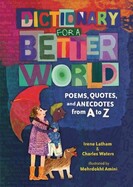 Dictionary for a Better World: Poems, Quotes, and Anecdotes from A to Z. Irene Latham & Charles Waters. Illus. by Mehrdokht Amini. (2020). Carolrhoda. This wisdom-packed dictionary nurtures readers with reflective thoughts and positive actions from Acceptance and Ally for A to Zest for Z. Each double-page entry includes a poem, an inspirational quote, an anecdote from one of the poets, a “try it” activity, and a richly-colored illustration created with acrylic paint, digital painting, collage, and photography. Back matter includes an author’s note, sources of quotes, recommended reading, poetry resources, and an index of poetic forms. (Gr 3 Up)  The Enigma Game. Elizabeth Wein. (2020). Hyperion. In November of 1940, fifteen-year-old Louisa Adair, an orphaned survivor of the London Blitz, takes a job caring for elderly Jane Warner (actually Johanna von Arnim, a German opera diva) at a pub in Windyedge, Scotland. When Louisa finds an enigma machine smuggled into Scotland by a German pilot, she and Jane, along with a pilot and a volunteer driver from the nearby RAF base, become involved in a code-breaking conspiracy that might help win the war. (Gr 6 Up) 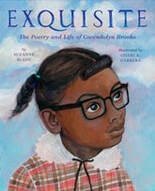 Exquisite: The Poetry and Life of Gwendolyn Brooks. Suzanne Slade. Illus. by Cozbi A. Cabrera. (2020). Abrams. With lovely free verse and acrylic paintings, this picture book celebrates the life of Gwendolyn Brooks (1917-2000), the first Black person to win the Pulitzer Prize in Poetry. Growing up in Chicago, she began writing poetry at the age of seven. Brooks’ poetry reflects on her childhood dreams, “real life” challenges of poverty and racial injustice, and the joy of sharing of stories through her poetry and prose. Back matter includes an author’s note, timeline, sources for quotes, and a bibliography. (Gr 3 Up) 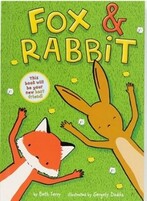 Fox & Rabbit (Fox & Rabbit #1). Beth Ferry. Illus. by Gergely Dudás. (2020). Amulet. Meet Fox (who likes to try new things but fears heights) and Rabbit (who likes being prepared but is afraid of everything else). In five linked stories, they support each other in conquering their fears while having adventures. The fun of reading the expressive panels, both the wordless ones and those with lively wordplay, of this graphic novel series for emerging readers continues in Fox and Rabbit Make Believe (2020) and Fox and Rabbit Celebrate (out April 2021). 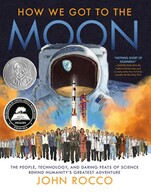 How We Got to the Moon: The People. Technology, and the Daring Feats of Science Behind Humanity’s Greatest Adventure. John Rocco. (2020). Crown. This well-researched book tells the story behind our country’s moon landing on July 24, 1969. Rocco’s engaging text (with illustrations, diagrams, and profiles of scientists, engineers, and others) is organized in seven parts beginning with the Cold War Space Race competition between the United States and Soviet Union in 1957 and ending with the Apollo 11 Mission in 1969. Back matter includes an epilogue, notes on the Apollo piloted missions (Apollo 7 in 1968 to Apollo 17 in 1972), and sources. (Gr 6 Up)  I Want to Sleep Under the Stars! (Unlimited Squirrels #3). Mo Willems. (2020). Hyperion. (PreK-Gr 2) All Zoom Squirrel wants to do is sleep under the stars for the first time, but when Zip Squirrel enlists the help of other squirrel friends to facilitate this, their noisy exuberance keeps Zoomy awake instead. Special features of Willems’ wildly imaginative, cartoony beginning reader include “emote-acorns” (happy, mad, surprised, and six more), a joke, quiz, news feature, fancy words, and facts about stars. (PreK-Gr 2)  Kenny & the Book of Beasts (Kenny & the Dragon #2). Tony DiTerlizzi. (2020). Simon & Schuster. A lot has happened since Kenny and the Dragon (2008) left off, but Grahame the dragon is still Kenny Rabbit’s best friend. When one of Grahame’s old friends, Dante the manticore, arrives in town, Kenny feels pushed out of the friendship, but they must still work together to defeat a witch, rescue another friend, and unlock a book. The Tales of Kenny Rabbit, a boxed set of the two books, was published in 2020. (Gr 3-5)  Lake (See to Learn #2). Kate Moss Gamblin. Illus. by Karen Patkau. (2020). Groundwood. The series of “Do you see” questions in Moss Gamblin’s simple, lyrical text guides young readers in carefully observing eye-catching digital illustrations as a child and an adult share activities such as fishing, swimming, canoeing, and watching the animals that live in or visit a lake throughout the year. Moss Gamblin includes a note on using the See to Learn books to initiate conversations about the treasures of the natural world. (PreK-Gr 2).  Lift. Minh Lê. Illus. by Dan Stantat. (2021). Disney Hyperion. Iris, who loves pushing the elevator buttons in her apartment building, gets angry when her younger brother starts pushing the buttons, too. Recovering a button panel discarded in a trash can by a repairman fixing an out-of-order elevator, Iris tapes it next to her bedroom closet. Pushing this button magically opens the door to other worlds—and Iris decides to share her fantasy adventures with her brother. (PreK-Gr 2) 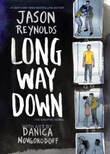 Long Way Down: The Graphic Novel. Jason Reynolds. Illus. by Danica Novgorodoff. (2020). Caitlyn Dlouhy. These are the rules: No Crying. No Snitching. Seek Revenge. Will takes his murdered brother Shawn’s gun with him in the elevator, which stops at each floor where a different ghost victim of gun violence from Shawn’s life joins him. By the time he reaches the ground floor, has Will changed his plan to follow the rules? This graphic novel, based on Reynolds’ 2018 Newbery Honor-winning novel in verse, is beautifully crafted and thought provoking. (Gr 9-12) 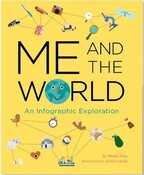 Me and the World: An Infographic Exploration. Mireia Trius. Illus. by Joana Casals. (2020). Chronicle. This engaging book explores a plethora of information and data on topics such as common names, types of families, populations of countries, most visited cities, sports, and breeds of dogs. Entries are presented in a variety of digitally-rendered infographic formats: charts, graphs, maps, labeled illustrations, and more. Trius includes sources with web links for facts in the book. (Gr 3-5) 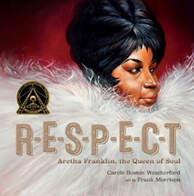 R-E-S-P-E-C-T: Aretha Franklin, the Queen of Soul. Carole Boston Weatherford. Illus. by Frank Morrison. (2020). Atheneum. Expressive oil paintings and rhyming couplets celebrate the life of African American Aretha Franklin (1942-2018), who as a pastor’s child sang in her church’s choir and recorded her first gospel album at age fourteen. The Queen of Soul had a long career as a singer, songwriter, pianist, and civil rights activist. She proudly sang “My Country ’Tis of Thee” at President Obama’s swearing-in ceremony. Back matter includes an author’s note and a list of Franklin’s biggest hits. (Gr 3 Up) 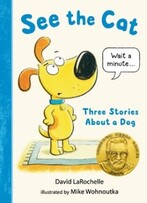 See the Cat: Three Stories About a Dog. David LaRochelle. Illus. by Mike Wohnoutka. (2020). Candlewick. An argument between the book and Max the Dog begins as the book’s “See the cat” statement is countered by Max’s response “I am not a cat. I am a dog.” The hilarity of their interaction continues until Max successfully wins the argument when he responds to the book’s threat to have the pictured purple hippo sit on him by saying he’ll leave the book. The book acquiesces, “See the dog take a nap.” Max replies, “Thank you, book.” (PreK-Gr 2) 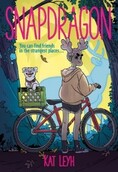 Snapdragon. Kat Leyh. (2020). First Second. In this middle-grade graphic novel, while searching for her missing dog, Snap, a black tween, finds that the town witch, Jacks, has been caring for the injured dog. Snap makes a deal to help Jacks in her preparation of roadkill skeletons to sell online in exchange for learning to care for the orphaned baby opossums she has rescued. Assisting Jacks, Snap wonders if the old woman really does have magical powers and uncovers a family secret that changes everything. (Gr 3-5) 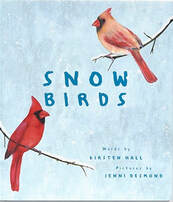 Snow Birds. Kirsten Hall. Illus. by Jenni Desmond. (2020). Abrams. Double-spread pairings of expressive poems and mixed media illustrations create a celebration of birds with adaptations and behaviors for surviving long, cold winters. The repetition of calls and songs of the birds such as the “Fee-bee! Fee-bee!” of the black-capped chickadee and the “Tea-kettle! Tea-kettle!” of the Carolina Wren invites the reading aloud of the poems. Endnotes provide basic information on each of the seventeen featured species. (PreK-Gr 2). 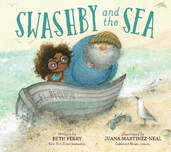 Swashby and the Sea. Beth Ferry. Illus. by Juana Martinez-Neal. (2020). Houghton Mifflin Harcourt. The serene life of retired Captain Swashby, who lives in a small house on a small beach, is disturbed when a young girl and her grandmother move into the empty house next door. He wants solitude, but the sea seems to know just what he really needs—friends—and sets about to see that he gets them in this charming and playful picture book (PreK-Gr 2). 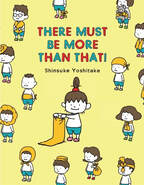 There Must Be More Than That! Shinsuke Yoshitake. (2020). Chronicle. When a young girl’s brother declares “Our future is doomed” and relates all the terrible things that grown-ups have told his friend are going to happen, Grandma tells her that no one really knows what will happen in the future. There will be bad things, but also many good things. “There are so many possible futures!” Reassured, the girl begins imaginative explorations of the possibilities and also learns there will always be many choices for her to make. (PreK-Gr 2) Nancy Brashear is Professor Emeritus of English from Azusa Pacific University, in Azusa, California. Carolyn Angus is former Director of the George G. Stone Center for Children's Books, Claremont Graduate University, in Claremont, California
|
AuthorsThese reviews are submitted by members of the International Literacy Association's Children's Literature and Reading Special Interest Group (CL/R SIG). Archives
May 2024
Categories
|

 RSS Feed
RSS Feed